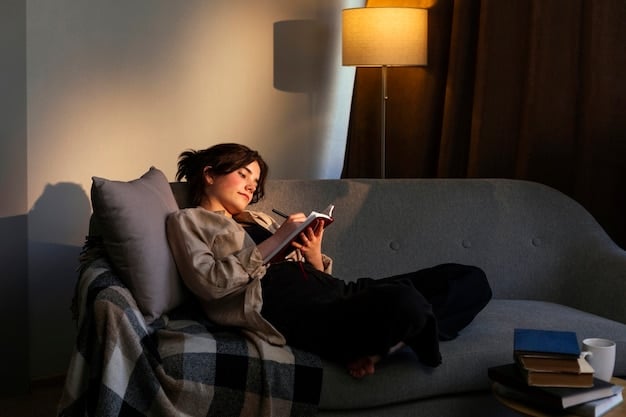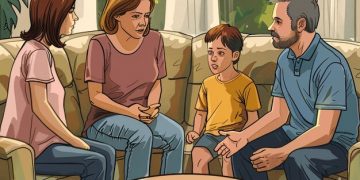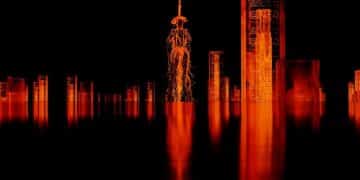Understanding SAD & Light Therapy Options in the US

Seasonal Affective Disorder, or SAD, is a type of depression linked to seasonal changes, most commonly appearing in fall and winter, and is often effectively managed with light therapy, a prominent treatment option available across the US.
As the days grow shorter and the skies turn gray, many individuals in the US experience a notable shift in their mood and energy levels. For some, this change transcends typical “winter blues” and manifests as a more profound condition known as Understanding Seasonal Affective Disorder (SAD) and Light Therapy Options in the US. This article delves into the intricacies of SAD, exploring its symptoms, causes, and a primary therapeutic approach: light therapy.
Understanding the Landscape of Seasonal Affective Disorder (SAD)
Seasonal Affective Disorder is a significant mental health condition characterized by recurrent episodes of depression that occur at a specific time of year, typically during the fall and winter months. These depressive episodes generally remit during the spring and summer. The impact of SAD can range from mild, manageable symptoms to severe impairment in daily functioning, affecting millions across the United States.
The core of SAD lies in its seasonal pattern. Unlike other forms of depression that may occur at any time, SAD is directly tied to the changing seasons, suggesting an intimate connection with natural light cycles. Understanding this timing is crucial for early recognition and intervention, which can significantly improve a person’s quality of life during the colder, darker months.
Biological Rhythms and SAD
Our bodies operate on intricate biological rhythms, most notably the circadian rhythm, which is heavily influenced by light and darkness. Disruptions to this delicate balance are believed to play a significant role in the development of SAD. Experts often point to several key biological factors that are thought to contribute to the disorder:
- Melatonin Imbalance: An overproduction of melatonin, the sleep-regulating hormone, may occur in individuals with SAD due to decreased natural light exposure. Higher melatonin levels can lead to increased drowsiness and lethargy.
- Serotonin Dysregulation: Serotonin, a neurotransmitter that regulates mood, is often found to be lower in people with SAD. Sunlight naturally helps increase serotonin levels, so reduced exposure can lead to a dip in this crucial chemical.
- Vitamin D Deficiency: Sunlight is a primary source of Vitamin D, which is essential for serotonin production and overall brain health. Lower levels of Vitamin D during darker months may exacerbate SAD symptoms.
These biological shifts collectively contribute to the depressive symptoms experienced by those with SAD. The interplay between light exposure, hormone regulation, and neurotransmitter balance forms a complex picture that researchers continue to unravel.
Recognizing the seasonal pattern of depression is the first step toward effective management. If symptoms consistently appear and disappear with the change of seasons, seeking a professional diagnosis is advisable. This condition is far more than just “feeling down” when the weather gets cold; it is a clinical diagnosis with specific criteria that require careful consideration.
Recognizing the Symptoms of SAD: What to Look For
Identifying SAD requires a keen awareness of specific symptoms that differentiate it from other types of depression. While general depressive symptoms like sadness and loss of interest are present, SAD has distinct features that align with its seasonal nature. The diagnostic criteria typically require at least two consecutive years of seasonal episodes followed by periods of remission.
Common symptoms of SAD often include not just emotional changes but also significant physical and behavioral shifts. These symptoms tend to be consistent from year to year during the affected season, making them predictable for individuals and their loved ones. Paying close attention to these patterns can aid in early detection and management.
Emotional and Behavioral Indicators
The emotional impact of SAD can be profound, often leading to a sense of hopelessness and withdrawal. Beyond the general feeling of sadness, specific emotional and behavioral changes are common:
- Persistent Low Mood: A pervasive feeling of sadness, gloom, or hopelessness that lasts for most of the day, nearly every day, typically starting in the fall or winter.
- Loss of Interest: A marked decrease in pleasure or interest in activities once enjoyed, including hobbies, social interactions, and work-related tasks.
- Irritability: Increased feelings of frustration or anger, often disproportionate to the situation, which can strain relationships.
- Social Withdrawal: A tendency to isolate oneself from friends, family, and social activities, preferring solitude over interaction.
These emotional symptoms can significantly impair an individual’s ability to engage with their daily life and maintain their usual routines. The feeling of being “stuck” in a cycle of negativity is a common complaint among those with SAD.
Physical and Cognitive Manifestations
SAD also brings a host of physical and cognitive symptoms that impact daily functioning. These can often be mistaken for general fatigue or minor physical ailments, but they are integral to the disorder:
- Hypersomnia: An excessive need for sleep, often sleeping for longer periods than usual but still feeling unrefreshed upon waking.
- Carbohydrate Cravings: An increased desire for sugary or starchy foods, which can lead to weight gain. This craving is thought to be the body’s attempt to increase serotonin levels.
- Low Energy (Lethargy): A profound lack of energy and persistent fatigue, making even simple tasks feel overwhelming.
- Difficulty Concentrating: Problems focusing, remembering details, and making decisions, affecting academic or professional performance.
The combination of these symptoms can make SAD a particularly debilitating condition, as it affects both mental clarity and physical stamina. Understanding this holistic impact is essential for developing effective treatment plans, many of which focus on addressing these pervasive aspects of the disorder.
The Science Behind Light Therapy for SAD
Light therapy, also known as phototherapy, stands as a primary and highly effective treatment for SAD. This non-invasive intervention involves daily exposure to a specific type of artificial light, mimicking natural sunlight, to alleviate the symptoms of seasonal depression. Its efficacy is rooted in its ability to regulate the biological mechanisms that are often disrupted in individuals with SAD.
The principle behind light therapy is relatively straightforward: by increasing light exposure, it aims to reset the body’s internal clock, reduce melatonin production, and boost serotonin levels. This regulation of key hormones and neurotransmitters helps to counteract the biochemical imbalances that contribute to depressive symptoms during darker months. The consistent application of this therapy is key to achieving optimal results.
How Light Therapy Works
The therapeutic benefits of light therapy are directly linked to its impact on the brain’s neurochemistry. The bright light emitted by therapy lamps is absorbed by the retina, sending signals to the brain that can influence mood, sleep, and appetite:
- Regulating Circadian Rhythms: Exposure to bright light, particularly in the morning, helps to resynchronize the body’s natural sleep-wake cycle, mimicking the effects of longer daylight hours. This can improve energy levels and sleep quality.
- Influencing Neurotransmitter Production: Light exposure stimulates the production of serotonin, often referred to as the “feel-good” hormone. Increased serotonin levels can significantly improve mood and reduce depressive symptoms.
- Suppressing Melatonin: Bright light can inhibit the body’s production of melatonin during the day, preventing the excessive daytime sleepiness and lethargy often experienced by those with SAD.
The specific wavelengths and intensity of light used in therapy lamps are crucial for their effectiveness. These devices are designed to filter out harmful UV rays while delivering the beneficial spectrum of light necessary for therapeutic impact. Daily, consistent use is typically recommended for best outcomes.
Types of Light Therapy and Devices
Various light therapy options are available, each with specific features designed to meet individual needs and preferences. While the core principle remains the same, the devices and their applications can differ:
- Light Boxes: These are the most common and widely recommended dispositivi for SAD treatment. They emit a broad spectrum of white light, delivering a brightness of 10,000 lux, which is significantly brighter than regular indoor lighting. Users typically position the box at arm’s length and allow the light to enter their eyes indirectly for 20-30 minutes daily.
- Dawn Simulators: These devices mimic a natural sunrise, gradually increasing light intensity in the morning to wake the user gently. While not as potent as light boxes for direct SAD treatment, they can be beneficial for regulating sleep patterns and providing a gentler wake-up.
- LED Light Therapy: Some devices utilize specific LED wavelengths. While research is ongoing, certain LED lamps are becoming popular, though not all meet the 10,000-lux standard for SAD treatment.
Choosing the right light therapy device often depends on individual symptoms, lifestyle, and a healthcare provider’s recommendations. It’s important to select a device specifically designed for SAD treatment to ensure it provides the correct intensity and spectrum of light for therapeutic effect.

Selecting the Right Light Therapy Lamp in the US
For individuals in the US considering light therapy for SAD, choosing the correct lamp is a critical first step towards effective treatment. The market offers a variety of devices, and understanding their specifications and features is essential to ensure the lamp provides the necessary therapeutic benefits. Not all light-emitting devices are suitable for SAD treatment; proper selection maximizes efficacy and safety.
Key considerations when selecting a light therapy lamp include brightness (measured in lux), type of light emitted, UV filtration, and overall design for practical, daily use. Consulting with a healthcare professional can also provide personalized guidance, especially for those with existing eye conditions or other health concerns.
Key Features of an Effective SAD Lamp
To ensure a light therapy lamp is effective for SAD, several technical specifications must be met. These features ensure that the device delivers the right kind of light required for therapeutic benefits, distinguishing them from ordinary desk lamps or other light sources:
- Brightness (Lux): The most crucial feature is a brightness of 10,000 lux. This intensity level is scientifically proven to be effective for SAD treatment. Lamps with lower lux levels may not provide sufficient light exposure to impact mood.
- UV Filtration: A high-quality SAD lamp should filter out almost all UV light to protect the eyes and skin from potential damage. Look for lamps explicitly stating “UV-filtered” or “UV-free” in their specifications.
- Light Spectrum: Most effective SAD lamps emit broad-spectrum white light, similar to natural sunlight. While some research explores specific wavelengths, broad-spectrum white light remains the most widely recommended.
- Minimal Glare: Good lamps are designed to minimize glare, making the therapy session more comfortable. Excessively harsh light can cause eye strain or headaches.
Understanding these technical aspects helps consumers make informed decisions, ensuring they invest in a device that will genuinely contribute to their well-being. Prioritizing these features over aesthetic appeal can lead to more successful outcomes in managing SAD symptoms.
Practical Considerations for Usage
Beyond the technical specifications, practical aspects of using a light therapy lamp significantly influence its effectiveness and user compliance. Integrating light therapy into daily routines requires a lamp that is both convenient and comfortable to use:
- Proximity and Angle: The lamp should be placed at an arm’s length (about 16-24 inches) from the face, with the light angled towards the eyes but not directly staring into it. The light needs to enter the eyes to affect the brain’s chemistry.
- Duration of Use: Typically, 20-30 minutes of daily exposure at 10,000 lux is recommended. Adjustments may be made based on individual response and medical advice. Consistency is key, preferably at the same time each morning.
- Portability and Design: Consider how the lamp fits into your lifestyle. Some lamps are compact and portable, ideal for travel or use in different rooms, while others are larger and better suited for a fixed location.
Choosing a lamp that fits well into one’s daily routine, whether during breakfast, while working, or reading, can significantly increase adherence to the treatment protocol. Ease of use and a comfortable experience contribute to a more positive and successful therapeutic journey for individuals dealing with SAD.
Integrating Light Therapy into Your Lifestyle in the US
Effective management of SAD through light therapy extends beyond merely owning a proper lamp; it involves strategically integrating its use into one’s daily routine. For individuals across the US, busy schedules and varying lifestyles present unique challenges, making thoughtful planning essential for consistent therapy. The goal is to make light therapy a seamless and regular part of the daily regimen, maximizing its benefits.
Successful integration often depends on finding the most convenient time and location for sessions. Consistency is paramount, as sporadic use may not yield the desired therapeutic effects. By approaching light therapy with a practical mindset, individuals can turn a clinical recommendation into a supportive daily habit that actively combats SAD symptoms.
Establishing a Routine
Consistency is the cornerstone of effective light therapy for SAD. Establishing a regular routine helps the body recognize and respond to the daily light exposure, thereby reinforcing the circadian rhythm and improving mood. Developing a routine involves planning the “when” and “where” of your therapy sessions:
- Morning Sessions: Most experts recommend using the light therapy lamp first thing in the morning, ideally within the first hour of waking up. This timing is most effective in resetting the body’s internal clock and inhibiting melatonin production.
- Consistent Timing: Try to use the lamp at the same time each day, even on weekends. This consistency helps to stabilize your sleep-wake cycle, which is often disrupted in SAD.
- Combine with Daily Activities: Integrate light therapy into activities you already do, such as eating breakfast, working at a desk, checking emails, or reading. This makes the therapy less of a separate task and more of a natural part of your morning.
By making light therapy an integral part of your morning ritual, you enhance its potential to alleviate SAD symptoms. The more consistently you adhere to a schedule, the more effectively your body can adjust to the therapeutic light, leading to sustained improvement in mood and energy levels.
Optimizing Your Environment
Beyond the light therapy sessions themselves, optimizing your living and working environment can further enhance the positive effects. Creating a bright, inviting space can contribute to overall well-being during the darker months, complementing the direct impact of light therapy:
- Maximize Natural Light: Open curtains and blinds during the day. Trim branches or clear obstructions that block sunlight from entering your home or office.
- Strategic Lighting: Use bright, full-spectrum lighting in areas where you spend a lot of time. While not a substitute for a SAD lamp, general bright light can still contribute to a more uplifting environment.
- Outdoor Exposure: Even on cloudy days, spending time outdoors can expose you to more natural light than being indoors. Short walks or outdoor activities can be beneficial.
These environmental adjustments, combined with consistent light therapy, create a holistic approach to managing SAD. By actively seeking out and utilizing light sources, both artificial and natural, individuals can effectively combat the seasonal downturns in mood and maintain a more balanced emotional state throughout the year.

Potential Side Effects and Precautions of Light Therapy
While light therapy is generally safe and well-tolerated, it’s crucial for users in the US to be aware of potential side effects and necessary precautions. Understanding these aspects ensures that the therapy is used safely and effectively, minimizing any adverse reactions. Most side effects are mild and temporary, often resolving as the body adjusts to the treatment or with minor adjustments to usage.
Discussion with a healthcare provider is always recommended before initiating light therapy, especially for individuals with pre-existing conditions, such as eye disorders or bipolar disorder. This professional guidance can help tailor the therapy to individual needs and identify any contraindications, ensuring a safe and beneficial experience.
Common Mild Side Effects
Most individuals experience minimal or no side effects from light therapy. However, some may encounter mild and usually temporary reactions, particularly when first starting treatment. These side effects often diminish as the body acclimates to the light:
- Eye Strain or Headache: Some users report sensitivity to the bright light, leading to eye strain or a mild headache. This can often be mitigated by adjusting the distance from the lamp or reducing the initial duration of sessions.
- Nausea or Jitters: A small percentage of individuals may feel slightly nauseous or agitated, similar to the feeling after consuming too much caffeine. This is usually a sign that the light intensity or duration is too high for the initial adjustment period.
- Sleep Disturbances: While light therapy aims to improve sleep, using it too late in the day can paradoxically interfere with nighttime sleep, leading to insomnia. Adhering to morning sessions is crucial for preventing this.
If any of these side effects occur, it’s advisable to cease treatment temporarily and consult a healthcare professional. Often, a slight adjustment to the timing, duration, or distance from the light source can resolve these issues, allowing the individual to continue with the therapy comfortably.
Important Precautions and Contraindications
Certain conditions or medications can make light therapy unsuitable or require careful supervision. It’s vital to be aware of these precautions to prevent serious complications. A thorough medical evaluation before starting light therapy is highly recommended for anyone with underlying health concerns:
- Eye Conditions: Individuals with certain eye conditions, such as glaucoma, cataracts, or retinal damage, should consult an ophthalmologist before using light therapy. The bright light could potentially exacerbate these conditions.
- Bipolar Disorder: For those diagnosed with bipolar disorder, light therapy could potentially trigger manic or hypomanic episodes. It should only be used under strict medical supervision and usually in conjunction with mood stabilizers.
- Photosensitizing Medications: Some medications can increase sensitivity to light, making light therapy potentially problematic. These include certain antibiotics, antipsychotics, and St. John’s wort. Always check with your doctor or pharmacist.
- Skin Conditions: While SAD lamps typically filter out UV light, individuals with photosensitive skin conditions or those prone to skin damage from light exposure should exercise caution and consult a dermatologist.
By understanding and adhering to these precautions, individuals can safely integrate light therapy into their SAD management strategy. Professional guidance ensures that the benefits of light therapy are fully realized without compromising overall health and well-being, paving the way for a more stable mood throughout the year.
Beyond Light Therapy: Complementary Strategies for SAD
While light therapy is a cornerstone in managing SAD, it is often most effective when combined with other supportive strategies. A holistic approach that integrates lifestyle adjustments, therapeutic interventions, and potentially medication can provide more comprehensive relief for individuals in the US battling seasonal depression. These complementary strategies address various aspects of well-being, supporting overall mental health alongside the direct effects of light therapy.
The aim is to create a multi-faceted plan that not only targets the direct symptoms of SAD but also promotes resilience and prevents recurrence. Understanding that SAD is a complex condition, a broad spectrum of interventions can yield better and more sustainable outcomes than relying on a single treatment modality.
Lifestyle Adjustments and Self-Care
Making conscious lifestyle choices can significantly impact the severity and duration of SAD symptoms. These self-care practices contribute to overall mental and physical health, creating a stronger foundation for managing seasonal mood changes:
- Consistent Exercise: Regular physical activity, even moderate, can significantly boost mood, reduce stress, and improve sleep quality. Exercise naturally increases endorphins, which have antidepressant effects.
- Balanced Diet: Consuming a nutritious diet rich in fruits, vegetables, and lean proteins can help stabilize blood sugar levels and provide essential nutrients for brain function. Limiting processed foods and excessive sugar can also reduce mood swings.
- Mindfulness and Stress Management: Practices like meditation, yoga, deep breathing exercises, or spending time in nature can help manage stress, reduce anxiety, and foster a sense of calm.
- Social Connection: Actively maintaining social connections, even when feeling withdrawn, can combat isolation and provide emotional support. Planning social activities, even small ones, can make a difference.
These lifestyle adjustments are not just supplemental; they are integral to a comprehensive SAD management plan. They empower individuals to actively participate in their own recovery and build resilience against future episodes, fostering a sense of control and well-being.
Professional Support and Therapeutic Options
For many individuals, combining light therapy with professional support from mental health specialists yields the best results. Therapies and, in some cases, medication can address deeper psychological issues or severe symptoms that light therapy alone might not fully resolve:
- Cognitive Behavioral Therapy (CBT): CBT specifically adapted for SAD (CBT-SAD) helps individuals identify and change negative thought patterns and behaviors associated with the seasonal changes. It focuses on developing coping skills and promoting adaptive responses.
- Psychotherapy: Discussing feelings and developing coping strategies with a therapist can provide invaluable support, helping individuals navigate the emotional challenges of SAD.
- Medication: Antidepressants, particularly selective serotonin reuptake inhibitors (SSRIs), may be prescribed in more severe cases of SAD or when light therapy and lifestyle changes prove insufficient. Medication is often used for a specific period during the symptomatic months.
- Vitamin D Supplementation: Given the link between Vitamin D deficiency and SAD, healthcare providers may recommend supplementation, especially during winter months when sun exposure is limited.
These professional interventions offer structured support and medical guidance, ensuring that individuals receive tailored care that addresses their specific needs and symptoms. By integrating multiple approaches, individuals with SAD can achieve a more stable and resilient mental state throughout the year, truly
| Key Point | Brief Description |
|---|---|
| ☀️ SAD Defined | Seasonal Affective Disorder is depression linked to seasonal changes, primarily in fall/winter. |
| 💡 Light Therapy Core | Artificial light mimics sun, regulating mood hormones (serotonin, melatonin). |
| ✔️ Lamp Selection | Requires 10,000 lux brightness and UV filtration for effectiveness. |
| 🩹 Holistic Approach | Combine light therapy with lifestyle, exercise, and professional support. |
Frequently Asked Questions About SAD and Light Therapy
▼
SAD is primarily linked to reduced exposure to natural light during fall and winter. This light reduction can disrupt the body’s internal clock (circadian rhythm), leading to imbalances in neurotransmitters like serotonin and melatonin, which regulate mood and sleep. Genetic predisposition and chemical imbalances are also contributing factors in the US.
▼
Many individuals report noticing improvements in their mood and energy levels within a few days to two weeks of consistent daily light therapy use. However, the full benefits may take up to four weeks to become apparent. Adherence to the recommended daily sessions is crucial for experiencing the full therapeutic effect.
▼
Reputable SAD light therapy lamps are designed to filter out harmful UV rays to protect your eyes. However, individuals with certain eye conditions (e.g., glaucoma, cataracts) or those taking photosensitizing medications should consult an ophthalmologist or doctor before starting light therapy to ensure it’s safe for them. Direct staring into the light source is not recommended.
▼
No, while light therapy is a highly effective primary treatment for SAD, it’s often complemented by other strategies. These can include psychotherapy (especially CBT), antidepressant medications for more severe cases, lifestyle adjustments like regular exercise and a balanced diet, and ensuring adequate Vitamin D levels. A holistic approach usually yields the best outcomes.
▼
Reliable light therapy lamps are widely available in the US from major online retailers, specialized medical supply stores, and some pharmacies. When purchasing, look for lamps that explicitly state they emit 10,000 lux of brightness and are UV-filtered. Checking for certifications from organizations like the FDA can also ensure product quality and safety for treating SAD.
Conclusion
Understanding and addressing Seasonal Affective Disorder is a crucial step towards maintaining mental wellness, particularly for those whose moods shift with the seasons. Light therapy stands out as a highly effective and accessible treatment option across the US, offering a non-invasive way to counteract the biological imbalances triggered by reduced light exposure. By recognizing the symptoms of SAD, selecting the right light therapy tools, and diligently integrating them into daily routines, individuals can significantly alleviate their seasonal depressive symptoms. Furthermore, combining light therapy with other complementary strategies—such as lifestyle adjustments, balanced nutrition, regular exercise, and professional psychological support—creates a robust framework for holistic well-being. Proactive management of SAD not only mitigates current symptoms but also builds resilience for future seasonal changes, empowering individuals to navigate the darker months with greater stability and a renewed sense of vitality.





